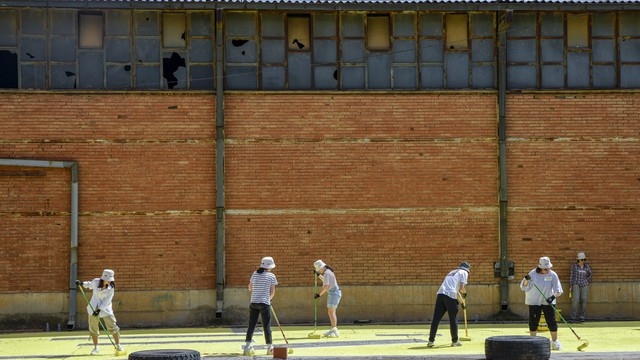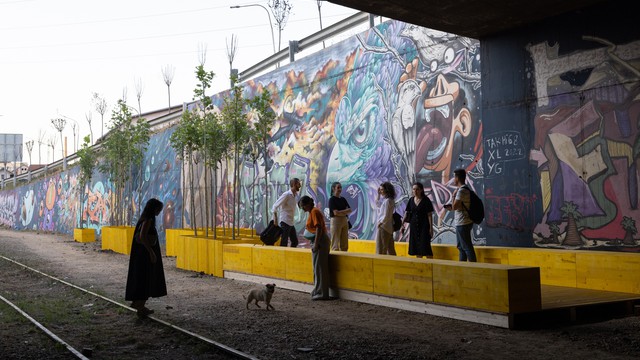Commons Sense, Manifesta 14 2022, Kosovo, Prishtina
Design interventions to reshape the public space in Prishtina, Kosovo







Commons Sense is the name for CRA’s Urban Vision, which comprises a set of temporary design interventions across the public space of Prishtina with the goal to launch a long-term, citizen-driven placemaking process. Its adoption of multimedia elements started right at the beginning, as the studio collaborated with MIT Senseable City Lab to digitally scan the streets – the city had been largely overlooked by Google Street View – and conduct rigorous big data analysis to identify places prime for transformation.
Having established a set of digital streetscapes of Prishtina, CRA set up low-cost and temporary structures at various places, some completed in 24 hours with just paint by local university students. The interventions mostly tackle the abandonment and misuses of public spaces. For instance, a discontinued railway track filled with cars and trash was cleaned up and turned into a pedestrian path dotted with seating and plants. Locals were invited to interact with these facilities however they wanted, and deliberate whether they should be kept, modified or discarded at the end of the experiment. By turning Prishtina into a vibrant “living lab”, the project perfectly enacts the process of participatory urbanism, which underscores citizens’ agency towards the space they live in.
Details
Descriptions
Facade type and geometry (structure) : While the results of Urban Vision were not conveyed with multimedia, digital technologies played an integral part in the initiative. Over three months in 2021, a streetscape was developed with local architecture students collecting footage of the city’s neighborhoods using a GoPro camera. After that, Senseable City Lab researchers processed the visuals with the help of AI. The materials were fed to a pre-trained object detection model and then a deep learning-based semantic segmentation model, so that different subjects (buildings, people, cars, trees etc.) and activities (walking, skateboarding etc.) are identified with colored masks. Ultimately, such extensive analyses of the built environment and human dynamics reveal the locations most apt to launch CRA’s Urban Vision. Moreover, the harvested data is set to be shared on an open-source basis to advance bottom-up urbanism processes.
Urban situation : Having experienced a tumultuous century, Kosovo’s public space had almost always taken a backseat. The scarce infrastructural heritage left behind by the Ottoman Empire, including the bazaar, was destroyed by Tito after the Second World War. His regime built spacious squares, but not a free civil society to inhabit them. Then came the war, national independence, and an unruly real estate expansion so chaotic that some scholars ominously called it “Turbo Urbanism”. As a result, cafes and restaurants abound in today’s Prishtina, but parks are rare and often without benches. Cars rule the squares and the few other remaining common areas. In response, we built on the discourse of “the battle for public space” put forward by former mayor Shpend Ahmeti, and sought to transform the traditionally rigid process of urban creation into one that is open and evolutionary.
Participatory architecture & urban interaction
Community or communities involved : As a project to realize CRA’s Urban Vision, Commons Sense thrived in Prishtina because it managed to engage the local communities in various capacities. First, the architecture students at the University of Prishtina took part in the process to scan the streets. With GoPro cameras on hand or on the helmet while riding a bike, they not only contributed invaluable urban data to the initiative, but also got to experience the city in a new way. Later on, they also helped set up the urban interventions by demarcating the activity spaces with yellow paint. When the interventions were opened, all the local residents had the chance to “vote with their feet”. By choosing whether and how to interact with the temporary structures, they become a key cog in the feedback loop, providing useful indicators of the designs’ potential to improve the public space, and implicitly deciding their destiny.
Host organization : Manifesta
Issues addressed : Commons Sense tackled the longstanding problem in Prishtina where citizens are alienated from the public space. A lack of planning in development is a root cause of the issue. To counter this, CRA's Urban Vision made a targeted effort by introducing an informed approach led by data and local citizens, which ensured that the ultimate results actually contribute to the long-term growth of the city. On a micro level, the initiative proposed solutions for various issues widespread in Prishtina, from eradicating illegal parking to reactivating abandoned buildings.
Impact : Some of the interventions executed by CRA in 2021 have been integrated into the city’s social fabric. For instance, the former Hivzi Sulejmani Library, whose external gates had been reclaimed from illegal parking for recreational use, was turned into a permanent cultural institution, the Centre for Narrative Practice. The former Brick Factory, first converted into an “urban living room”, was transformed by the Biennal and German practice Raumlabor into a temporary Eco Urban Learning Center. Working with Kosovo’s Ministry of Culture, Youth and Sport, CRA also helped pedestrianize a vibrant alley that is known to locals as Kafet e Rakis (Rakia’s cafes). These projects show how “open-source urbanism” can enact change in different contexts.
Tools used : (Scanning phase) GoPro Cameras (Data Analysis phase) Mask R-CNN, a pre-trained object detection model; another deep learning-based semantic segmentation model trained in the ADE20K dataset (Construction phase) Paint, wooden planks and cubes, trees (Acer platanoides and Robinia pseudoacacia) grown in planters
Next steps : Having populated Prishtina’s public space during Manifesta 14, the interventions from Commons Sense such as the Green Corridor – a kilometer-long pedestrian pathway, converted from an abandoned railway track and now dotted with plants and seating to connect disjointed neighborhoods – are still serving the city, and are set to be re-assessed to maximize their urban potential.
Mediacredits
Atdhe Mulla
Ivan Erofeev
MIT Senseable City Lab
Atdhe Mulla
MIT Senseable City Lab
Atdhe Mulla
Ivan Erofeev
CRA-Carlo Ratti Associati